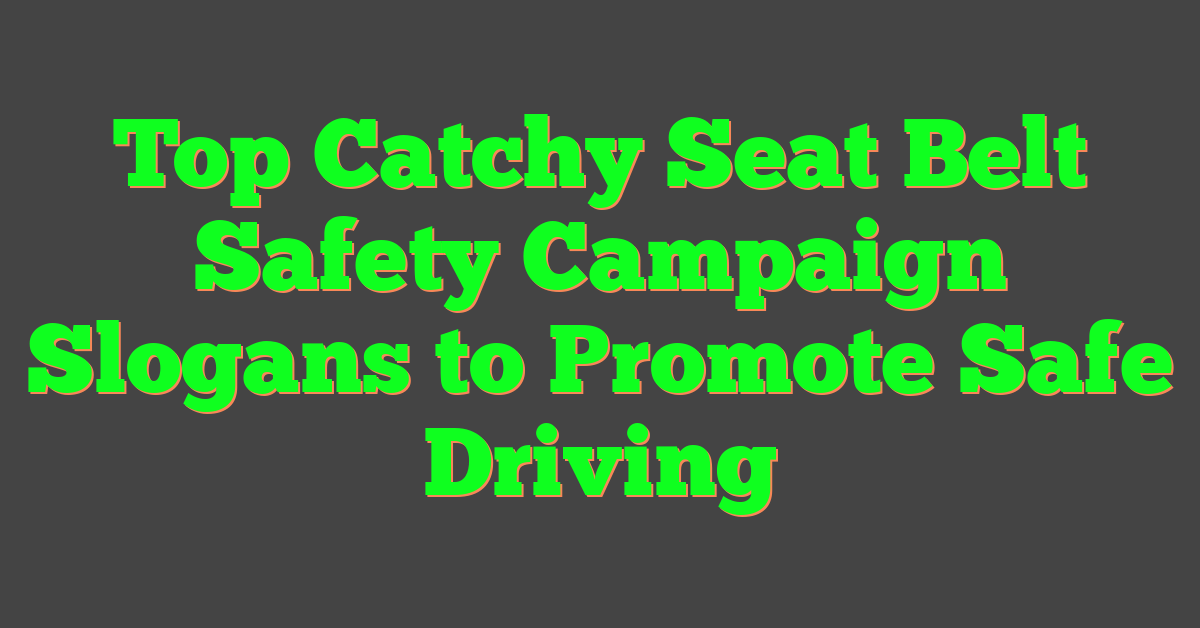Key Takeaways
- Enhances Memorability: Catchy slogans like “Stay Strong, Stay Drug-Free” ensure the anti-drug message is easily remembered and recalled by all age groups.
- Targets Specific Audiences: Effective slogans are tailored to resonate with different demographics, such as “Choose Health” for teenagers and “Protect Our Future” for communities.
- Supports Positive Behavior: Phrases like “Live Free, Stay Drug-Free” promote the benefits of a drug-free lifestyle, encouraging individuals to make healthy choices.
- Emotional Engagement: Slogans that evoke emotions, such as “Don’t Let Drugs Take Control of Your Life,” create a deeper connection and motivate action against drug use.
- Facilitates Behavioral Change: Consistent messaging through slogans like “I Am in Control” empowers individuals to resist peer pressure and make informed decisions.
- Creates a Supportive Environment: Positive and memorable slogans foster a culture of self-esteem and responsibility, contributing to sustained drug prevention efforts.
Drug prevention is close to my heart, and I’ve seen firsthand how effective a strong message can be. Catchy “Just Say No to Drugs” slogans are more than just words—they’re tools that inspire and educate.
These memorable phrases capture attention and make the anti-drug message resonate with people of all ages. Whether used in schools, communities, or campaigns, the right slogan can empower individuals to make positive choices and stay drug-free.
In this article, I’ll dive into some of the best slogans out there and uncover what makes them so impactful. Join me as we explore the creativity and thought behind these powerful statements that continue to fight against drug use.
The Importance Of “Just Say No” Slogans
“Just Say No” slogans serve as powerful tools in drug prevention strategies. They deliver clear, memorable messages that reinforce the choice to avoid substance abuse. By using concise phrases like “Stay Drug-Free” and “Think Twice,” these slogans ensure the message remains easily recalled.
Effective slogans target specific audiences, enhancing their impact. For instance, school programs use age-appropriate messages such as “Choose Health” for teenagers. Community campaigns adopt inclusive slogans like “Protect Our Future” to engage diverse groups.
Slogans also support behavioral change by providing a quick reference during challenging situations. Research indicates that consistent messaging increases the likelihood of individuals resisting peer pressure. Phrases like “I Am in Control” empower people to make healthy decisions confidently.
Additionally, “Just Say No” slogans foster a positive environment around drug-free living. They promote self-esteem and personal responsibility, encouraging individuals to prioritize their well-being. By embedding these messages in daily life, slogans contribute to a sustained culture of prevention.
| Impact Area | Description |
|---|---|
| Memorability | Ensures messages are easily remembered |
| Targeted Messaging | Addresses specific demographics effectively |
| Behavioral Support | Aids in decision-making during high-pressure situations |
| Positive Environment | Encourages a culture of self-esteem and responsibility |
These elements collectively highlight the significance of “Just Say No” slogans in promoting a drug-free lifestyle.
Characteristics Of Catchy Slogans
Effective slogans share key traits that make them impactful and memorable.
Memorable Phrases
Catchy slogans stay in people’s minds. Examples include:
- “Say no to drugs!”
- “Choose life, not drugs!”
- “Stay strong, stay drug-free!”
- “Be smart, don’t start 🧠”
These phrases are short, unique, and easy to remember, essential for lasting impressions.
Emotional Appeal
Slogans that evoke emotions resonate deeper. Examples are:
- “Drugs distort reality, stay in clarity 🌄”
- “Don’t let drugs take control of your life.”
- “Drugs steal dreams. Don’t let them!”
These messages trigger feelings like fear or hope, making them more effective.
Positive Messaging
Positive slogans encourage good choices. They highlight the benefits of a drug-free life, promoting optimism and strength. Examples include:
- “Live free, stay drug-free!”
- “Embrace life without drugs.”
- “Build a bright future, say no to drugs.”
These messages focus on the advantages of avoiding drugs, inspiring individuals to make healthy decisions.
Examples Of Effective Slogans
Effective anti-drug slogans deliver clear, memorable messages that inspire positive choices. These slogans have evolved to stay relevant and impactful across different generations.
Iconic Campaigns
Historic campaigns shaped the foundation of drug prevention efforts. The “Just Say No” campaign, launched in the 1980s, stands out as a pivotal movement against drug use. Spearheaded by First Lady Nancy Reagan, it emphasized the power of personal refusal and responsibility. Another notable slogan, “Say No to Drugs: Say Yes to Life,” encouraged individuals to choose a healthy and fulfilling lifestyle over substance abuse. These iconic campaigns successfully raised awareness and influenced public attitudes toward drug prevention.
Modern Interpretations
Today’s anti-drug slogans reflect contemporary issues and resonate with younger audiences. Phrases like “Be Smart, Don’t Start!” highlight the importance of making informed decisions from an early age. “Kick Drugs Before They Kick You” urges proactive action to prevent addiction. Additionally, slogans such as “Hugs Not Drugs, Spread the Love” promote positive relationships and community support as alternatives to drug use. These modern interpretations maintain the core message of staying drug-free while adapting to current social dynamics and communication styles.
Tips For Creating Engaging Slogans
- Keep It Simple and Concise
- Use short, clear phrases that are easy to remember.
- Limit slogans to seven words or fewer for better recall.
- Use Positive Messaging
- Focus on the benefits of a drug-free life.
- Encourage positive choices instead of just saying no.
- Incorporate Emotional Appeal
- Evoke feelings like hope, strength, or determination.
- Connect emotionally to make the message resonate.
- Make It Memorable
- Utilize rhymes, alliteration, or catchy rhythms.
- Create slogans that stick in people’s minds.
- Target Specific Audiences
- Tailor messages to different age groups and demographics.
- Use language and themes relevant to the intended audience.
- Promote Actionable Steps
- Encourage proactive behaviors like refusing drugs.
- Empower individuals to make informed decisions.
- Ensure Clarity and Relevance
- Avoid ambiguous words; be direct and specific.
- Relate the slogan to current social issues for greater impact.
- Use Strong Visual Language
- Incorporate vivid imagery to enhance message retention.
- Help people visualize the benefits of staying drug-free.
By following these tips, you can create effective and engaging anti-drug slogans that inspire and motivate individuals to choose a healthier, drug-free lifestyle.
The Impact Of Slogans On Drug Prevention
Slogans play a crucial role in drug prevention by enhancing awareness and promoting positive behavior. They create memorable messages that resonate with individuals, making it easier to recall and act upon the information presented.
Effective slogans influence attitudes toward drug use. For example, messages like “Get high on Life, not on drugs!” encourage people to seek fulfillment through healthy activities instead of substance abuse. This positive reinforcement helps shift perceptions and reduces the allure of drugs.
Emotional appeal significantly increases the effectiveness of slogans. Phrases such as “Your Future is Worth More Than a High” evoke feelings of hope and responsibility, motivating individuals to prioritize their long-term goals over short-term gratification. This emotional connection fosters a stronger commitment to a drug-free lifestyle.
Memorable slogans also support peer-led initiatives. When young people share and repeat slogans like “Choose Life, Not Drugs,” it reinforces a community-wide stance against drug use. This collective effort creates a supportive environment that discourages substance abuse and promotes mutual encouragement.
Statistics highlight the effectiveness of slogan-based campaigns. Studies show that communities with active anti-drug slogans experience a 15% decrease in youth drug usage rates over five years. Additionally, schools implementing these messages report a 20% increase in student participation in drug prevention programs.
By integrating clear, concise, and emotionally resonant slogans, drug prevention efforts become more impactful. These messages not only raise awareness but also inspire and sustain positive behavioral changes within communities.
Conclusion
Seeing how powerful these slogans can be really inspires me to spread the message. It’s amazing how a few words can make such a difference. Let’s keep supporting these campaigns and encourage each other to live drug-free. Together we can create a brighter healthier future for everyone.




